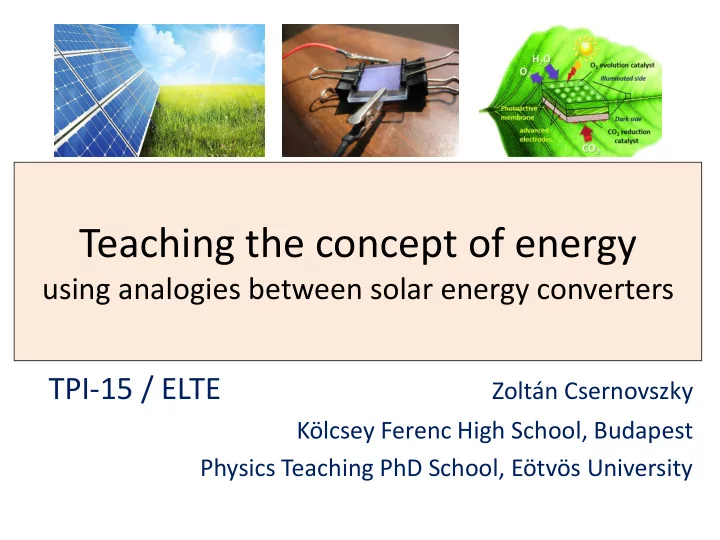

Teaching the concept of energy using analogies between solar energy converters TPI-15 / ELTE Zoltán Csernovszky Kölcsey Ferenc High School, Budapest Physics Teaching PhD School, Eötvös University
Solar Energy Interactions LIGHT Photon-Electron Converters Photo- Dye sensitized n-p junction solar cell Solar Cell Synthesis Raspberry Analogies Cell Energy Electron Analogue Levels Processes Transports Project Works Pedagogical Applications Interdisciplinarity
Absorption of a photon by an electron Molecular systems Crystal lattices Photon absorption by an electron Thermalisation 4 Ionisation 1 Generation of an electron – hole pair Excitation 1 of the electron Photoinduced homolytic cleavage 2 𝐵 ∶ 𝐶 + ℎ𝜑 → 𝐵 ∙ + ∙ 𝐶 Dissociation 1 Energy storage inside the molecule 2 Photo-induced transfer of electron 5 𝑩: − + 𝑪 + 𝑩 ∶ 𝑪 + 𝒊𝝋 → Principle of photovoltaic systems 3 : DSSC 5 N-P JUNCTION SC 5 PHOTOSYNTHESIS SEMICONDUCTORS SOLAR CELLS
Conversion of photon ’s energy: Solar Chemical energy energy Photosynthesis Water Carbon-dioxide Photon ’s energy Glucose Dioxygen 𝟕𝑫𝑷 𝟑 + 𝟕𝑰 𝟑 𝑷 + 𝒊𝝋 → Photolysis ∶ (𝐈 𝟑 𝑷) + 𝒊𝝋 → 𝟐 𝟑 𝑷 𝟑 + 𝟑𝒇 − + 𝟑𝑰 + → 𝑫 𝟕 𝑰 𝟐𝟑 𝑷 𝟕 + 𝟕𝑷 𝟑
Conversion of photon ’s energy: semiconductors 1 Solar Electrical energy energy Absorption of an electron and generation of an electron- hole pair in a semiconductor. The band gap determines how much energy is needed to excite the electron that it can participate in conduction. The excitation of an electron into the CB results also a hole in the VB. Thus, both the electron and hole can participate in conduction 3 . Two types of semiconductors
Conversion of photon ’s energy: Solar Electrical energy energy single n-p junction solar cells CB CB p Exposed charges are n unable to move Photostability VB VB or sensitivity Before joining to the visible spectrum? After joining diffusion Solar spectrum at sea level diffusion Energy bands of a single n-p junction 1.7 OPTIMAL GAP 1.1 Formation of an electric field 3.1 VISIBLE 1.6 in depletion region
Conversion of photon ’s energy: Dye-sensitized solar cells 1 Separatation of functions in a DSCC Main steps and electron transfer in a DSCC
Pedagogical applications 1: electron transport analogies A Photosystem II Chlorophyll aII Depletion region Dye /Anode e- transport chain SC n-type (CB) TiO 2 /Anode Anode FTO glass /Anode Chlorophyll aI Outer circle Outer circle Photosystem I Cathode Cathode e- transport chain DSSC SC p-type Electrolyte SC PHSY Final receptor
Pedagogical Applications 2: Energy levels analogies Relative energy levels diagrams Photosynthesis DSSC TiO2 /N719 elte_hyplin_redoxpot.docx Single n-p junction SC
Pedagogical Applications 3: Analogue Processes STEP PHOTOSYNTHESIS n-p JUNCTION SC DSSC Photosystem II (chlorophyll all) Excitation − + ℎ𝜉 → 𝑓 𝐷𝐶 − GR𝐸𝑧𝑓 + ℎ𝜉 → 𝐹𝑌𝐸𝑧𝑓 𝑓 𝑊𝐶 Photosystem I (chlorophyll aI) Charge Oxydation of Dye: e - / h + generation: Dissociation water (photolysis): separation − + 𝐵𝐷 → 𝐹𝑌𝐸𝑧𝑓 → 𝑓 𝑊𝐶 2 𝐼 2 𝑃 → (𝑷 𝟑 +𝟓𝒇 − ) + 𝟓𝑰 + − + 𝒊 + → 𝒇 𝑫𝑪 − + 𝑬𝒛𝒇 + → 𝒇 𝑻𝑫,𝑫𝑪 𝑾𝑪 PS II → e - transport chain → PS I Electron 𝐸𝑧𝑓 → 𝑈𝑗𝑃 2 → 𝐺𝑈𝑃 → ReactionCenter → Depletion → n-typeSC CB transport → 𝐷𝑏𝑢ℎ𝑝𝑒𝑓 → p-typeSC VB → Final Acceptor → 𝐹𝑚𝑓𝑑𝑢𝑠𝑝𝑚𝑧𝑢𝑓 - LDR Reduction of electron- Iodine regeneration: carrier NADP+ to NADPH Re- − + 2𝑓 − → 3𝐽 − . e - / h + recombination 𝐽 3 generation -Calvin Cycle/ Step 2: Reduction of CO 2 (Reactions VB → e − e − CB +h + VB + AC + Dye Regeneration: VB using e - from NADPH/ ATP.) 2 𝐸𝑧𝑓 + + 3𝐽 − → -Calvin Cycle /Step 3: → 2𝐻𝑆𝐸𝑧𝑓 + 𝐽 3 − Regeneration of RuBP.
Pedagogical Applications : Raspberry Cell Project Works The realization of a DSSC is an exciting way for teachers to place the notion of energy into an interdisciplinary context. You can examine a new type of solar cells and underline the similarities between photovoltaic systems and photosynthesis. Explore its photovoltaic properties PROJECT WORKS Compare to a „ classical ” Solar Cell Build your own elte_hyplink_bac_physics.docx Raspberry Cell Use different dyes Explore voltage and photostability elte_hyplink_raspcell_proj.docx Examine the effect of light-source type Compare spectral responses Projects Steps - elte_hypl_pr_steps.docx Pedagogical Objectives – Correlations to Hungarian Standards elte_hyplink_corr.docx
CONCLUSION To help an interdisciplinary energetical approach of these solar energy converters we showed - 3 comparative figures to follow their electron transports - 3 relative energy levels figures to strenghten the analogy - a recap-table to follow the main steps of processes - a Pedagogical Application to build and examine your own Raspberry Cell Chemical Charge Stockage Energy Absorp- Electron Solar Separa- tion Transport Energy tion Electrical Energy Electron Regeneration Sources Externes/ To Go Further: elte_hyplink_sources.docx
Recommend
More recommend